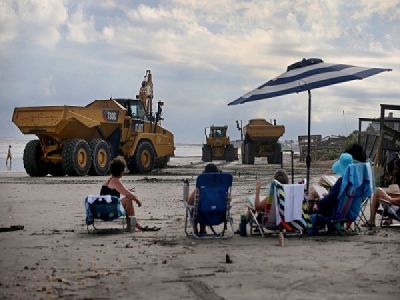
Posted on January 23, 2018
By Prentiss Findlay, The Post and Courier
More than 1 million cubic yards of sand is being dredged and pumped ashore at Isle of Palms to put back what Mother Nature stole from the beach during stormy weather in the fall.
The same sort of thing will happen starting in March at Folly Beach, but the sand will come from the Folly River.
The IOP project is costing more than $11 million and will place the equivalent of more than 80,000 dump truck loads of sand on the beach in the gated Wild Dunes community. Funding sources include $5.2 million from Wild Dunes property owners; $3.4 million from the state Department of Parks, Recreation & Tourism; and $2.9 million from the city.
The IOP work, which began this week, is considered maintenance of an erosion control project that began in 2008. It is also a fix for beach damage from Hurricane Matthew, which slammed the area in October 2016.
But the project could be growing in scope because of the effects of Tropical Storm Irma, which hit in September.
On Tuesday, the City Council agreed to spend $350,000, which will be combined with $150,000 from Wild Dunes, to seek matching federal funding for the additional beach improvements.
The expanded project, which could cost about $2 million, would put another 281,000 cubic yards of sand on the beach — the equivalent of about 23,000 dump truck loads.
Adding the second, smaller project to the ongoing renourishment is seen as a way to save costs because it wouldn’t be necessary to start from scratch on things like hiring a dredge and getting the necessary permits.
“It’s better to do it now,” said IOP Mayor Jimmy Carroll.
IOP council approved the $350,000 from a contingency fund based on a beach study in December that determined Irma caused the eastern end of the island to lose another 281,000 cubic yards of sand.
The ongoing IOP project is happening in Wild Dunes between January and March, from 57th Avenue to Dewees Inlet. An additional month of work would be added to the contract if its scope is expanded.
Dan Slotchiver said erosion threatens his parents’ oceanfront residence in the Beachwood East section of Wild Dunes. Back in the 1980s, there was plenty of beach at that location, but now because of the persistent erosion problems, the tide washes underneath the dwellings during major storms.
“My parents are deeply impacted. The renourishment is a welcome event. We anticipate phenomenal results from it,” he said.
The $10 million Folly project will run from March to September and will place 750,000 cubic yards of beach from 8th Street East to near Lighthouse Inlet Heritage Preserve at the island’s east end.
“At high tide we’ve lost pretty much all of our beach,” said Andy Lassiter, who lives on Folly’s front beach in the area to be renourished. “It will be very welcome, much needed.”
Most of the beach at Folly that is being renourished will remain open to the public, the U.S. Army Corps of Engineers said Thursday.
At any given time, the area fenced-off for beach nourishment will be about 1,000 feet long and easy to get around. Public crossover ramps will be installed for pipelines that will carry sand along the beach, the Corps said.
A pipeline carrying sand from the river to the beach will cross the road at The Washout, where a state-approved ramp will be built over the pipeline so firetrucks and other vehicles can cross over it, said Folly Mayor Tim Goodwin.
The Folly renourishment is to repair Hurricane Matthew beach damage and is entirely federally-funded, Goodwin said.
“We’re ready to get started,” he said.
In a related effort, the city of Folly Beach and the state are rehabilitating the long fingers of rock and timber that jut into the surf and help stabilize the beach between 8th Street East and 14th Street East. The restoration of the nine groins is a $3 million project. As the groins are restored, the beach renourishment project will place sand around them.
Historically, Folly Beach has suffered most from erosion because the Charleston Harbor jetties block the southerly flow of sand that would otherwise replenish the beach. For that reason, Folly has a long-term agreement with the federal government which provides substantial assistance for renourishment.
In contrast, the Sullivan’s Island beach has grown over the years as the sand that would have otherwise flowed south to Folly stacked up on the Sullivan’s side of the jetties. IOP has suffered from beach erosion near Breach and Dewees inlets and has experienced sand loss in other parts of the island, too.
Source: The Post and Courier





